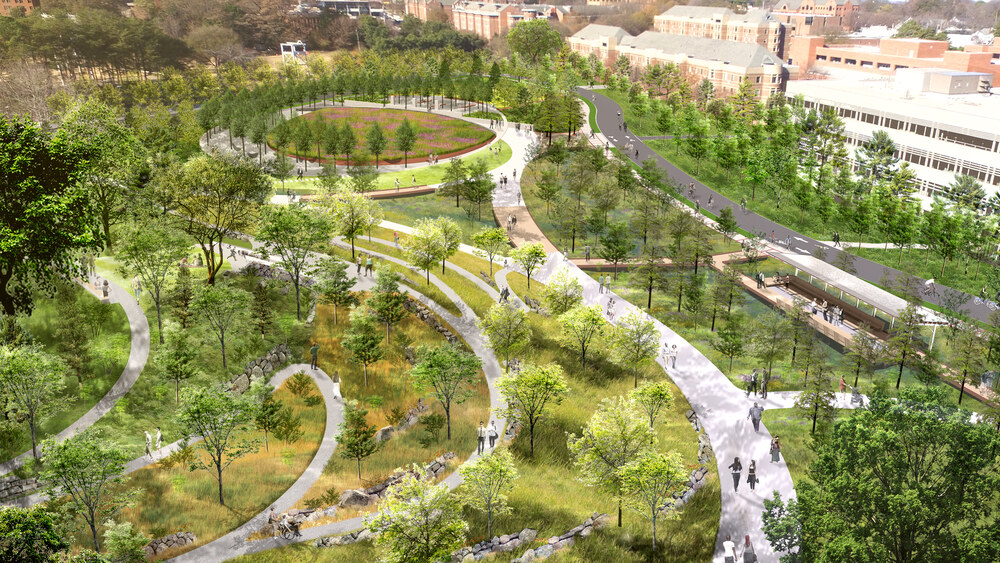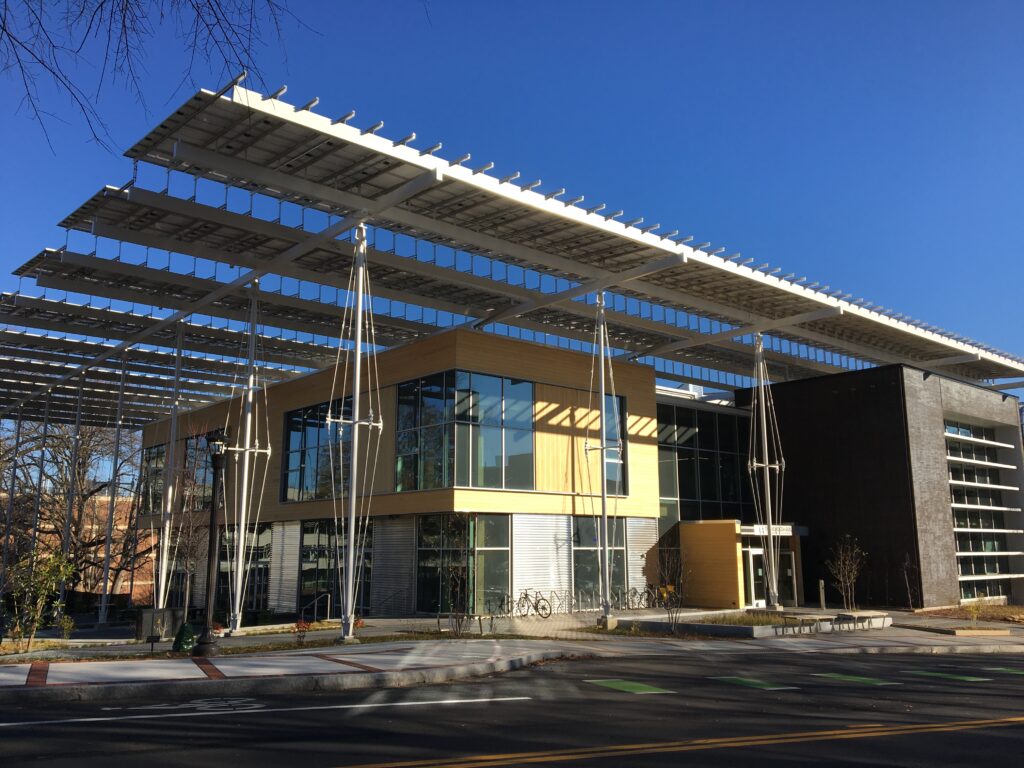
Kendeda Building for Innovative Sustainable Design (December 2019) by Kent Linthicum
I’ve always wanted to teach outside, and the COVID-19 pandemic practically forced me into it. As an environmental humanist who teaches courses on settler-colonialism and the Anthropocene, being outside seemed like an opportunity to engage with nature and have students be able to relate our work to a more immediate world. For numerous reasons, both mundane (the weather) and complex (accessibility for students and my own job market precarity) I had been reluctant. As reports began to show that being outside and distant were the safest ways to gather during this continuing pandemic and after I was informed that I had to teach some in-person classes, I turned outside. Teaching outside can be effective when teachers and students have the tools and the spaces they need. Lessons can approach or even exceed what they are inside. Not every school has made appropriate preparations for teaching outside though, which means instructors have to figure it out on their own. What I found, building my outside pedagogy from the ground up, was that teaching outside can help draw tangible connections among environmental course materials. Teaching outside, though, requires more preparation and different kinds of preparation that consider the challenges of being in the open air, like noise, weather, and technology.
Teaching in the Time of COVID-19
This semester, Fall 2020, my class theme is climate change and humor. The class is inspired by the work of Nicole Seymour on “Bad Environmentalism,” as well as Whitney Phillips and Ryan Milner on Internet culture and memes. The environmental theme made justifying class outside to students easy. First, I selected a location. Then, I had to determine what I could or could not do outside. For the physical location, I picked a patio near the room where my class had originally been scheduled. I figured it would be easy to find and already had the requisite infrastructure for groups of people. For the content, because my class is a multimodal composition class, I decided that in-person class periods would focus on the invention portion of each project. This way we could talk through the theoretical texts that were going to inform my students’ projects. In total, that meant I would meet with my students five to six times over the semester. Overall, I think this arrangement makes a lot of sense, as asking students to write outside—in a way that doesn’t require laptops or electricity—presents a challenge. Getting together to talk over complex concepts like queer environmentalism, environmental justice, or meme affordances seemed like a great fit for in-person classes as, through discussion, we could refine and expand our understanding of these critical topics.
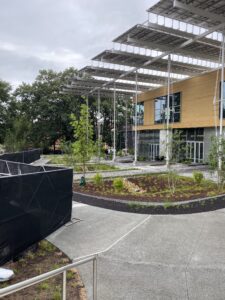
The Kendeda patio on the building’s western face, its only outside seating space (August 2020) by Kent Linthicum
For my first class I decided to give a lecture and conduct a full-class discussion about climate change and its mechanics. I figured lecturing in a more traditional, expository, the-professor-helps-clarify-what-you-read mode, would work well, as I could guide the students through the material, with no technology, and still explain what they had read. And then the discussion activity would give students the opportunity to talk, which they were surely starved for.
Unfortunately, lecturing and class discussion proved to be a greater challenge than I had anticipated. Facemasks and ambient noise made lecturing harder. While I can project more through my mask and pause through the rhythmic beeps of backing tractors, it is hard to motivate students—who can be quiet and difficult to hear inside classrooms, when the doors are shut and everyone’s listening—to speak up. Unsurprisingly, lecturing outside only further disadvantages English language learners, women, people with speech impediments, and others who might have issues with speaking, hearing, or being understood. And while I could project well for 50 minutes, the next 50 minutes were much harder. And often when students responded to my questions, they had a hard time hearing each other because of the factors mentioned above. So, I was constantly repeating their questions, only further taxing my voice. By the last class period I had lost my voice completely. After my first whole day of teaching, I scrapped all my plans for lectures and full-class discussions.
Instead, I focused on small group discussion. I would outline a series of questions, and then break the students into groups of three to four. As I got better at planning classes outside, I thought through the questions more, and what students could or could not accomplish. I also circulated through the groups in a more active way than I would in a pre-pandemic classroom: rather than just listening and expecting to center our conversations afterwards, I would engage with the groups by asking them to describe their on-going discussions to me. I decided that if my students had rich conversations for 50 minutes with three to four other classmates, that was a success.
Additionally, there were positives to being outside. For my class, our evidence was right there. For instance, as I was trying to help students understand queer environmentalism’s critique of gendered, binary nature, I could just point to objects like the trees, flowers, insects, birds, cars, buildings, etc. and ask the student to tell me (without thinking about it) what ‘gender’ those things are. For instance, students were quick to label flowers feminine and buildings masculine. They puzzled over trees for a bit, but decided they were more feminine. Seeing students realize how ingrained gendered notions of nature were, while examining a tree was wonderful. Then we discussed why that kind of gendering warps our perception regarding the arguably queer realities of ecological systems. While the same conversation could have been had in a classroom, being able to engage with the natural world directly helped bring depth to student responses, as they were able to use what they saw to inform their analysis.
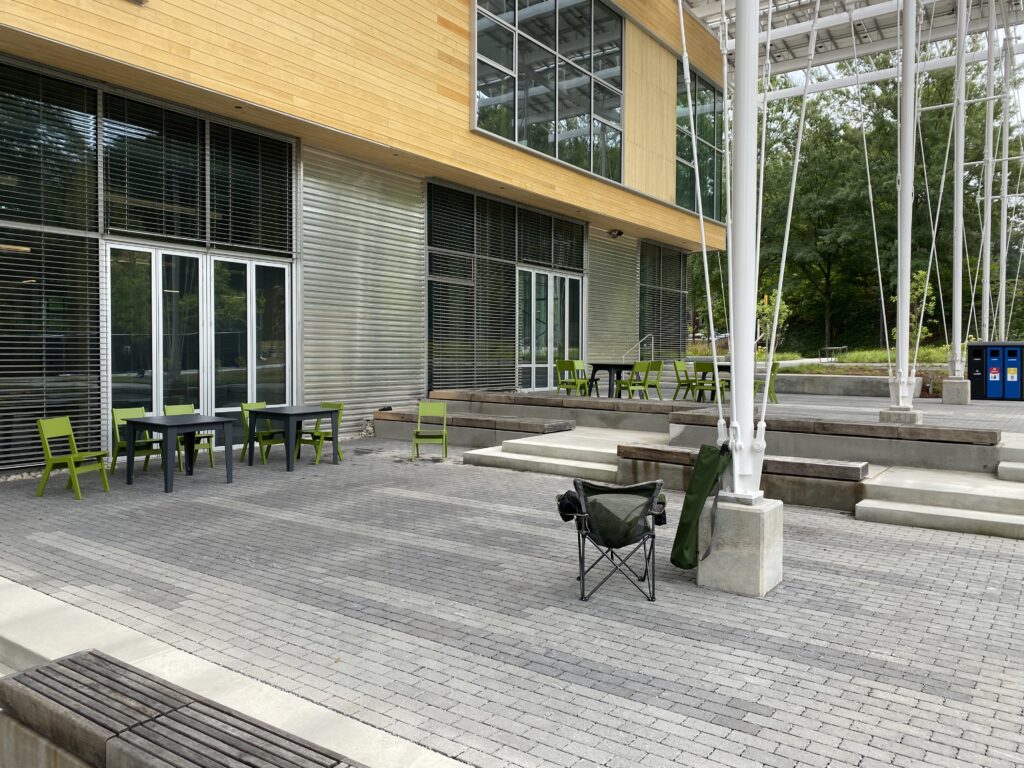
My Kendeda ‘classroom’ (August 2020) by Kent Linthicum
For me, this experiment has been a success, but I think I still have much to learn. One space I have not experimented with is having students do short projects outside. For instance, asking them to explore the still-under-construction eco-commons gendering everything they see to better understand how we as a culture imagine natural spaces and how that influences action. That is on my list as another possibility for good outside pedagogy, but will have to be developed in another article. In the mean time, here are my tips for teaching outside:
- Prepare and dress accordingly – I try to dress in business casual when teaching in a classroom. That was not going to work outside for five hours, though. Instead, I wore clothes more suited for hiking. I’m bald, so I wore a hat. I made sure I had enough water and some food. And, I brought my own chair. I had an umbrella if it rained. I made sure to contact my students and warn them to prepare similarly. All of this is more effort than strolling leisurely down the hall from my office to a classroom, but it is certainly safer right now.
- Plan thoughtfully – It is harder to hear outside (especially with masks), and technology is either inaccessible or difficult to use. For some instructors, especially depending on discipline, that might not be a challenge at all. Class work that involves small groups and collaboration do well. Also, exercises that ask students to spread out or use space differently are quite useful, like asking students to split up for discussion or sending them walking around nearby to collect data. During small group discussions, I circulate and talk with my students, trying to help them understand the material and refine their thoughts.
- Be generous – Unsurprisingly, designing and executing a lesson plan outside is harder. Students are at times shyer or even more distractible than they might normally be, so being kind and thoughtful about their mental/emotional state is key. I typically grade participation during class, and I still do, but now I am much more generous with points. So long as the student is engaged and paying attention, I am likely to give them full credit. Normally, I would have required either immediate comments or notes. Now, simply having students visibly pay attention to a discussion of environmental justice is a win in my (grade)book. I should also add that I have to remember to be generous with myself. At times teaching outside makes me feels as though I have forgotten how to teach. I haven’t, but it requires much more effort to do what usually seems like second nature, and I leave my ‘classroom’ feeling more dispirited in my own professional ability. So, I have to remember to be generous both with my students and myself.
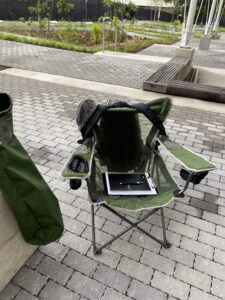
My ‘teacher’s desk’ (August 2020) by Kent Linthicum
Finally, I want to note that teaching a hybrid class right now is emotionally and physically draining. Prior to the pandemic, I could get to campus, do some light work, go to my classes, have lunch, then stay on campus for meetings, writing, and office hours. Now I go from my home to the Kendeda patio, I stay there for my classes, then head home. But the process leaves me exhausted. It takes more energy to conduct this kind of class: more energy to talk, more to think, more to do everything. When I schedule a hybrid class, I recognize that I’m not going to do any other work that day. No grading, no writing, no applying for other jobs, because I just won’t have the energy. So, when planning an outside hybrid day—and maybe just any hybrid day in general—I would encourage instructors to plan carefully for the physical and emotional toll it will take on them.
Days of Future Past
Originally, I requested a remote course. However, because I had no ‘reason’ to teach remote (other than a fear of injury or death from the virus) I was put into a ‘hybrid touch points’ class. Georgia Tech defines the ‘touch points’ class as ones that “will offer lectures in an online format and will bring students to the classroom several times during the semester for meaningful in-person experiences.” Faced with that requirement, I wanted to figure out how I could teach without further endangering my life or my student’s lives. I also wanted to find a solution because I am worried.
On September 7th, President Cabrera send an e-mail titled “Tracking Coronavirus on Campus” to students, faculty, and staff. In it, he thanks everyone for their efforts for reducing the spread of the coronavirus on campus. There was one paragraph that caught my attention, though:
“On the academic side, the efforts of our faculty to transform their courses into a hybrid format have been instrumental in reducing density in our classrooms and academic buildings. Yet these changes have inevitably also reduced the opportunities for students to interact with their faculty and with other students in their classes. As our data continues to support the effectiveness of our campus safety protocols, I encourage our faculty to think of additional ways to facilitate safe face-to-face learning interactions that will enrich the academic experience of our students.”
The short paragraph above is made-up of only three sentences, and it says a great deal to me that the second sentence starts with “Yet.” It suggests that the president is mainly unhappy despite the praise he offers in the first sentence. And, this is why I am worried: “facilitat[ing] safe face-to-face learning interactions” means Georgia Tech—and surely other colleges and universities—wants to find ways to increase a residential instruction. This was confirmed in a message from the provost on October 28th which described Georgia Tech’s tentative plans for Spring 2021. The provost writes,
“We will approach the spring course modes with the following goals […] Maximize the number of courses offered in residential and hybrid course modes. [And] For hybrid courses, increase the number of meaningful and regular interactions to provide students greater opportunity for personal engagement with faculty, academic staff, and peers.”
This plan is risky. Currently, the United States continues to watch its case count spike to even higher levels. And predictions suggest that winter will be even worse. Georgia Tech seems to be betting that things will cool down by January 2021, and/or that the Institute will be able to weather the initial storm of infections as it did this fall. I believe this puts faculty at a crossroads: either we figure out what works for us now, or colleges and universities will decide what works for them and tell us what to do (and, of course, ‘us’ here largely means contingent faculty). In this case, I think being outside threads the needle of risk in a way that keeps students, staff, and faculty safer than if we all pile back into classrooms.
To be clear, I don’t think being outside will work for everyone and every class. There are still issues, like poor weather and the general lack of infrastructure for this kind of teaching. And, I think a robust offering of remote, asynchronous classes should be part of this conversation. However, I also think we need other options, like teaching outside. The COVID-19 pandemic is just another part of the Anthropocene, one more disruption the faculty of the 21st century are going to face as our world becomes increasingly unfamiliar and unpredictable. The Anthropocene and climate change necessitate thinking of new ways of teaching. I think teaching outside should be one tool in our kit, something instructors might deploy during extended power outages, long-term internet disruptions, newer pandemics, or other looming disasters.

